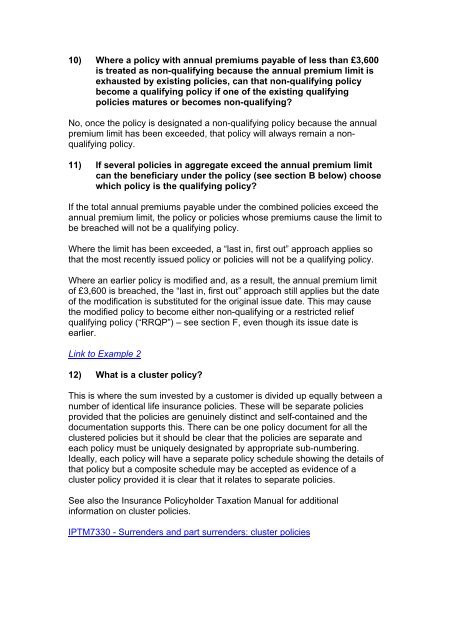FAQ's – Life Insurance – Qualifying Policies - HM Revenue & Customs
FAQ's – Life Insurance – Qualifying Policies - HM Revenue & Customs
FAQ's – Life Insurance – Qualifying Policies - HM Revenue & Customs
Create successful ePaper yourself
Turn your PDF publications into a flip-book with our unique Google optimized e-Paper software.
10) Where a policy with annual premiums payable of less than £3,600<br />
is treated as non-qualifying because the annual premium limit is<br />
exhausted by existing policies, can that non-qualifying policy<br />
become a qualifying policy if one of the existing qualifying<br />
policies matures or becomes non-qualifying?<br />
No, once the policy is designated a non-qualifying policy because the annual<br />
premium limit has been exceeded, that policy will always remain a nonqualifying<br />
policy.<br />
11) If several policies in aggregate exceed the annual premium limit<br />
can the beneficiary under the policy (see section B below) choose<br />
which policy is the qualifying policy?<br />
If the total annual premiums payable under the combined policies exceed the<br />
annual premium limit, the policy or policies whose premiums cause the limit to<br />
be breached will not be a qualifying policy.<br />
Where the limit has been exceeded, a “last in, first out” approach applies so<br />
that the most recently issued policy or policies will not be a qualifying policy.<br />
Where an earlier policy is modified and, as a result, the annual premium limit<br />
of £3,600 is breached, the “last in, first out” approach still applies but the date<br />
of the modification is substituted for the original issue date. This may cause<br />
the modified policy to become either non-qualifying or a restricted relief<br />
qualifying policy (“RRQP”) <strong>–</strong> see section F, even though its issue date is<br />
earlier.<br />
Link to Example 2<br />
12) What is a cluster policy?<br />
This is where the sum invested by a customer is divided up equally between a<br />
number of identical life insurance policies. These will be separate policies<br />
provided that the policies are genuinely distinct and self-contained and the<br />
documentation supports this. There can be one policy document for all the<br />
clustered policies but it should be clear that the policies are separate and<br />
each policy must be uniquely designated by appropriate sub-numbering.<br />
Ideally, each policy will have a separate policy schedule showing the details of<br />
that policy but a composite schedule may be accepted as evidence of a<br />
cluster policy provided it is clear that it relates to separate policies.<br />
See also the <strong>Insurance</strong> Policyholder Taxation Manual for additional<br />
information on cluster policies.<br />
IPTM7330 - Surrenders and part surrenders: cluster policies

















